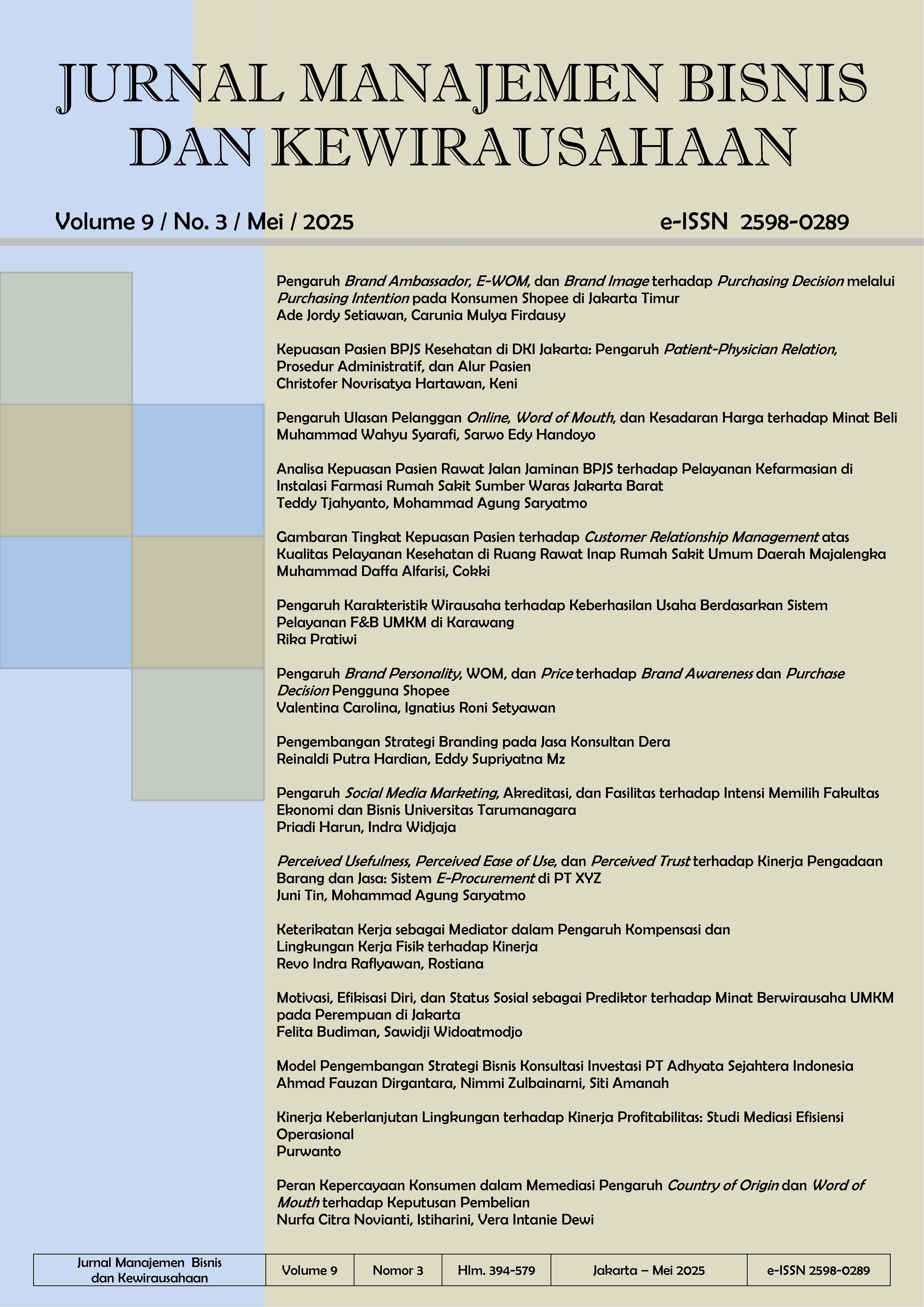Model pengembangan strategi bisnis konsultasi investasi PT Adhyata Sejahtera Indonesia
Main Article Content
Abstract
This study aims to formulate strategic directions for the business development of PT Adhyata Sejahtera Indonesia (PT ASI) in order to enhance competitiveness, expand market reach, and strengthen service value in the investment consulting services sector. The method employed is a qualitative case study with a descriptive approach, involving Business Model Canvas (BMC) analysis to understand the company's operations, internal factor analysis using the Resource-Based View (RBV) approach and VRIO matrix, as well as external factor analysis using the External Factor Evaluation (EFE) Matrix. Subsequently, strategies are formulated through SWOT analysis and the IE Matrix, and prioritized using the Quantitative Strategic Planning Matrix (QSPM). The research findings show that PT ASI is positioned in Quadrant V of the IE Matrix with total weighted scores of 2.604 (IFE) and 2.624 (EFE), recommending a hold and maintain strategy through market penetration and product development. Seven alternative strategies were generated through SWOT analysis, and three main strategies were prioritized through QSPM: optimizing business networks, enhancing service value, and proactively communicating government policy changes. Optimizing the business network emerged as the top priority, with concrete plans such as network mapping, strengthening collaborations, improving the quality of business matching events, and utilizing AI-based technology to create new business opportunities.
Penelitian ini bertujuan untuk merumuskan arah strategis pengembangan bisnis PT Adhyata Sejahtera Indonesia (PT ASI) guna meningkatkan daya saing, memperluas jangkauan pasar, dan memperkuat nilai layanan di sektor jasa konsultasi investasi. Metode yang digunakan adalah studi kasus kualitatif dengan pendekatan deskriptif, melibatkan analisis Business Model Canvas (BMC) untuk memahami operasional perusahaan, analisis faktor internal melalui pendekatan Resource-Based View (RBV) dan matriks VRIO, serta analisis faktor eksternal menggunakan Matriks External Factor Evaluation (EFE). Selanjutnya, strategi dirumuskan melalui analisis SWOT dan Matriks IE, serta diprioritaskan menggunakan Quantitative Strategic Planning Matrix (QSPM). Hasil penelitian menunjukkan bahwa PT ASI berada pada kuadran V Matriks IE dengan skor total tertimbang 2,604 (IFE) dan 2,624 (EFE), merekomendasikan strategi hold and maintain melalui penetrasi pasar dan pengembangan produk. Tujuh alternatif strategi dirumuskan melalui analisis SWOT, dan tiga strategi utama diprioritaskan melalui QSPM, yaitu optimalisasi jaringan bisnis, peningkatan nilai layanan, dan komunikasi proaktif terhadap perubahan kebijakan pemerintah. Optimalisasi jaringan bisnis menjadi prioritas utama dengan rencana konkret seperti pemetaan jaringan, penguatan kolaborasi, peningkatan kualitas acara business matching, serta pemanfaatan teknologi berbasis kecerdasan buatan untuk menciptakan peluang bisnis baru.
Article Details

This work is licensed under a Creative Commons Attribution-NonCommercial-ShareAlike 4.0 International License.
This work is licensed under a Jurnal Manajemen Bisnis dan Kewirausahaan Creative Commons Attribution-ShareAlike 4.0 International License.
References
Agung, G., Ratih, A., Sari, M., Gde, I., & Baskara, K. (2018). Pengaruh pertumbuhan ekonomi, suku bunga, dan nilai tukar terhadap investasi asing langsung di Indonesia. E-Jurnal Manajemen Universitas Udayana, 7(7), 4002–4030.
Biro Pusat Statistik. (2021). Hasil Sensus Penduduk 2020. Jakarta.
Biro Pusat Statistik. (2024, June 11). Jumlah penduduk menurut kelompok umur dan jenis kelamin, 2023.
David, F. R., & David, F. R. (2015). Strategic management: Concepts and cases - A competitive advantage approach (16th ed.). Pearson.
Gordon, I. (2002). Best practices: Customer relationship management. Retrieved from www.iveybusinessjournal.com
Hakim, R. (2012). Hubungan ekspor, impor dan produk domestik bruto (PDB) sektor keuangan perbankan Indonesia periode tahun 2000: Q1 – 2011:Q4: Suatu pendekatan dengan model analisis vector autoregression (VAR). Universitas Indonesia
Hochstein, A. (2020). The Harrod-Domar model, the money market and the elasticity of the investment demand curve. International Advances in Economic Research, 26(2), 197–198.
Kambono, H., & Marpaung, E. I. (2020). Pengaruh investasi asing dan investasi dalam negeri terhadap pertumbuhan ekonomi Indonesia. Jurnal Akuntansi, Program Studi Akuntansi, Fakultas Ekonomi, Universitas Kristen Maranatha, 12(1), 137–145.
Karantinou, K. M., & Hogg, M. K. (2001). Exploring relationship management in professional services: A study of management consultancy. Journal of Marketing Management, 17(3–4), 263–286.
Kurniasih, E. P. (2020). Perkembangan investasi asing di negara ASEAN. In Prosiding Seminar Akademik Tahunan Ilmu Ekonomi dan Studi Pembangunan 2020 (pp. 362–370).
Miller, D. (2019). The resource-based view of the firm. In Oxford Research Encyclopedia of Business and Management. Oxford University Press.
Organisation for Economic Co-operation and Development (OECD). (2018). Mapping of investment promotion agencies in OECD countries. Retrieved from www.oecd.org/investment/Mapping-of-Investment-Promotion-Agencies-in-OECD-Countries.pdf
Spence, A. M. (1974). Market signaling: Informational transfer in hiring and related screening processes. Harvard University Press.
Teece, D. J. (2007). Explicating dynamic capabilities: The nature and microfoundations of (sustainable) enterprise performance. Strategic Management Journal, 28(13), 1319–1350.
Teece, D. J., Pisano, G., & Shuen, A. (1997). Dynamic capabilities and strategic management. Strategic Management Journal, 18(7), 509–533.
Valdez-De-Leon, O. (2016). A digital maturity model for telecommunications service providers. Technology Innovation Management Review, 6.
Wan, X., & Zhao, P. (2024). Research on the impact of artificial intelligence on corporate competitive advantage. Frontiers in Business, Economics and Management, 17(3), 438–443.
Westerman, G., Bonnet, D., & McAfee, A. (2014). Leading digital: Turning technology into business transformation. Harvard Business Review Press.


